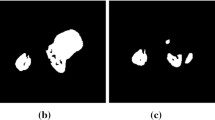Abstract
We present a novel unsupervised domain adaptation method for small bowel segmentation based on feature disentanglement. To make the domain adaptation more controllable, we disentangle intensity and non-intensity features within a unique two-stream auto-encoding architecture, and selectively adapt the non-intensity features that are believed to be more transferable across domains. The segmentation prediction is performed by aggregating the disentangled features. We evaluated our method using intravenous contrast-enhanced abdominal CT scans with and without oral contrast, which are used as source and target domains, respectively. The proposed method showed clear improvements in terms of three different metrics compared to other domain adaptation methods that are without the feature disentanglement. The method brings small bowel segmentation closer to clinical application.
Access this chapter
Tax calculation will be finalised at checkout
Purchases are for personal use only
Similar content being viewed by others
References
Small bowel obstruction (2019). https://my.clevelandclinic.org/health/diseases/15850-small-bowel-obstruction
Berga, D., Masana, M., de Weijer, J.V.: Disentanglement of color and shape representations for continual learning (2020)
Chen, Y., Chen, W., Chen, Y., Tsai, B., Wang, Y.F., Sun, M.: No more discrimination: cross city adaptation of road scene segmenters. In: IEEE International Conference on Computer Vision, pp. 2011–2020 (2017)
Çiçek, Ö., Abdulkadir, A., Lienkamp, S.S., Brox, T., Ronneberger, O.: 3D U-Net: learning dense volumetric segmentation from sparse annotation. In: Ourselin, S., Joskowicz, L., Sabuncu, M.R., Unal, G., Wells, W. (eds.) MICCAI 2016. LNCS, vol. 9901, pp. 424–432. Springer, Cham (2016). https://doi.org/10.1007/978-3-319-46723-8_49
Fedorov, A., et al.: 3D slicer as an image computing platform for the quantitative imaging network. Magn. Reson. Imaging 30(9), 1323–1341 (2012). https://doi.org/10.1016/j.mri.2012.05.001
Goodfellow, I., et al.: Generative adversarial nets. In: Advances in Neural Information Processing Systems, vol. 27, pp. 2672–2680 (2014)
Jiang, J., Veeraraghavan, H.: Unified cross-modality feature disentangler for unsupervised multi-domain MRI abdomen organs segmentation. In: Martel, A.L., et al. (eds.) MICCAI 2020. LNCS, vol. 12262, pp. 347–358. Springer, Cham (2020). https://doi.org/10.1007/978-3-030-59713-9_34
Ju, Z., et al.: Automatic segmentation of pelvic organs-at-risk using a fusion network model based on limited training samples. Acta Oncol. 59(8), 933–939 (2020). https://doi.org/10.1080/0284186X.2020.1775290
Liu, Y., et al.: CT-based multi-organ segmentation using a 3D self-attention u-net network for pancreatic radiotherapy. Med. Phys. 47(9), 4316–4324 (2020). https://doi.org/10.1002/mp.14386
Loshchilov, I., Hutter, F.: Decoupled weight decay regularization. In: International Conference on Learning Representations (2019)
Murphy, K.P., McLaughlin, P.D., O’Connor, O.J., Maher, M.M.: Imaging the small bowel. Curr. Opin. Gastroenterol. 30(2), 134–140 (2014)
Oda, H., et al.: Visualizing intestines for diagnostic assistance of ileus based on intestinal region segmentation from 3D CT images. ar**v preprint ar**v:2003.01290 (2020)
Sartor, H., et al.: Auto-segmentations by convolutional neural network in cervical and anorectal cancer with clinical structure sets as the ground truth. Clin. Transl. Radiat. Oncol. 25, 37–45 (2020). https://doi.org/10.1016/j.ctro.2020.09.004
Shin, S.Y., Lee, S., Elton, D., Gulley, J.L., Summers, R.M.: Deep small bowel segmentation with cylindrical topological constraints. In: Martel, A.L., et al. (eds.) MICCAI 2020. LNCS, vol. 12264, pp. 207–215. Springer, Cham (2020). https://doi.org/10.1007/978-3-030-59719-1_21
Shu, Z., Sahasrabudhe, M., Alp Güler, R., Samaras, D., Paragios, N., Kokkinos, I.: Deforming autoencoders: unsupervised disentangling of shape and appearance. In: Ferrari, V., Hebert, M., Sminchisescu, C., Weiss, Y. (eds.) ECCV 2018. LNCS, vol. 11214, pp. 664–680. Springer, Cham (2018). https://doi.org/10.1007/978-3-030-01249-6_40
Sudre, C.H., Li, W., Vercauteren, T., Ourselin, S., Jorge Cardoso, M.: Generalised dice overlap as a deep learning loss function for highly unbalanced segmentations. In: Cardoso, M.J., et al. (eds.) DLMIA/ML-CDS -2017. LNCS, vol. 10553, pp. 240–248. Springer, Cham (2017). https://doi.org/10.1007/978-3-319-67558-9_28
Tsai, Y., Hung, W., Schulter, S., Sohn, K., Yang, M., Chandraker, M.: Learning to adapt structured output space for semantic segmentation. In: IEEE/CVF Conference on Computer Vision and Pattern Recognition, pp. 7472–7481 (2018)
Wang, S., Yu, L., Li, K., Yang, X., Fu, C.-W., Heng, P.-A.: Boundary and entropy-driven adversarial learning for fundus image segmentation. In: Shen, D., et al. (eds.) MICCAI 2019. LNCS, vol. 11764, pp. 102–110. Springer, Cham (2019). https://doi.org/10.1007/978-3-030-32239-7_12
Wu, Y., He, K.: Group normalization. ar**v preprint ar**v:1803.08494 (2018)
Yang, J., Dvornek, N.C., Zhang, F., Chapiro, J., Lin, M.D., Duncan, J.S.: Unsupervised domain adaptation via disentangled representations: application to cross-modality liver segmentation. In: Shen, D., et al. (eds.) MICCAI 2019. LNCS, vol. 11765, pp. 255–263. Springer, Cham (2019). https://doi.org/10.1007/978-3-030-32245-8_29
Zhang, W., et al.: Mesenteric vasculature-guided small bowel segmentation on 3-D CT. IEEE Trans. Med. Imaging 32(11), 2006–2021 (2013). https://doi.org/10.1109/TMI.2013.2271487
Zhu, J., Park, T., Isola, P., Efros, A.A.: Unpaired image-to-image translation using cycle-consistent adversarial networks. In: IEEE International Conference on Computer Vision, pp. 2242–2251 (2017)
Acknowledgments
We thank Dr. James Gulley for patient referral and for providing access to CT scans. This research was supported by the National Institutes of Health, Clinical Center.
Author information
Authors and Affiliations
Corresponding author
Editor information
Editors and Affiliations
1 Electronic supplementary material
Below is the link to the electronic supplementary material.
Rights and permissions
Copyright information
© 2021 Springer Nature Switzerland AG
About this paper
Cite this paper
Shin, S.Y., Lee, S., Summers, R.M. (2021). Unsupervised Domain Adaptation for Small Bowel Segmentation Using Disentangled Representation. In: de Bruijne, M., et al. Medical Image Computing and Computer Assisted Intervention – MICCAI 2021. MICCAI 2021. Lecture Notes in Computer Science(), vol 12903. Springer, Cham. https://doi.org/10.1007/978-3-030-87199-4_27
Download citation
DOI: https://doi.org/10.1007/978-3-030-87199-4_27
Published:
Publisher Name: Springer, Cham
Print ISBN: 978-3-030-87198-7
Online ISBN: 978-3-030-87199-4
eBook Packages: Computer ScienceComputer Science (R0)





